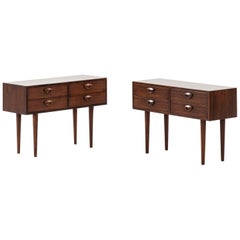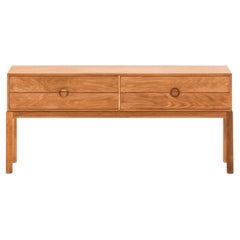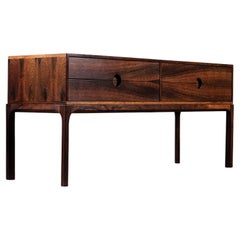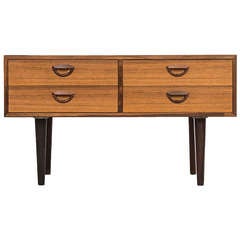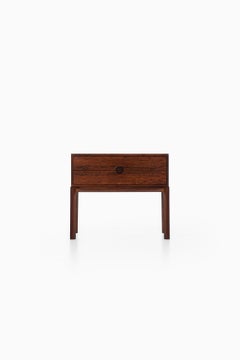Kai Kristiansen Bureau
Kai Kristiansen Bureaus Model Nr 50 by Feldballes Møbelfabrik in Denmark
By Kai Kristiansen
Located in Limhamn, Skåne län
Rare pair of bureaus model nr 50 designed by Kai Kristiansen. Produced by Feldballes Møbelfabrik in
Category
Vintage 1950s Danish Scandinavian Modern Commodes and Chests of Drawers
Materials
Rosewood
$7,773 / set
H 22.84 in W 33.47 in D 12.6 in
Kai Kristiansen Bureau / Side Table Model 394 by Aksel Kjersgaard in Denmark
By Kai Kristiansen
Located in Limhamn, Skåne län
Bureau / side table model 394 designed by Kai Kristiansen. Produced by Aksel Kjersgaard in Denmark.
Category
Vintage 1950s Danish Scandinavian Modern Commodes and Chests of Drawers
Materials
Oak
$5,381
H 20.48 in W 46.46 in D 13.78 in
Bureau by Kai Kristiansen for Aksel Kjersgaard, Denmark, 1960s
By Kai Kristiansen
Located in Stockholm, SE
Bureau / small sideboard model 394 by danish designer Kai Kristiansen.
Produced by Aksel
Category
Vintage 1960s Danish Scandinavian Modern Sideboards
Materials
Walnut
$7,175
H 20.48 in W 14.18 in D 46.46 in
Recent Sales
Kai Kristiansen Bureau in Rosewood by Feldballes Møbelfabrik
By Kai Kristiansen
Located in Limhamn, Skåne län
Kai Kristiansen bureau in rosewood produced by Feldballes møbelfabrik in Denmark.
Category
Vintage 1960s Danish Mid-Century Modern Dressers
Materials
Rosewood
Kai Kristiansen bureaus for Magda
By Kai Kristiansen
Located in Limhamn, Skåne län
2 bureaus by Kai Kristiansen
Item 124649 & 118859
Category
Vintage 1960s Danish Scandinavian Modern Commodes and Chests of Drawers
Materials
Rosewood
Kai Kristiansen Bureau in Rosewood by Feldballes Møbelfabrik in Denmark
By Kai Kristiansen
Located in Limhamn, Skåne län
Small bureau / sideboard designed by Kai Kristiansen. Produced by Feldballes Møbelfabrik in Denmark.
Category
Vintage 1960s Danish Scandinavian Modern Commodes and Chests of Drawers
Materials
Rosewood
H 23.23 in W 33.86 in D 12.6 in
Kai Kristiansen Bureau / Side Table Model 384 by Aksel Kjersgaard in Denmark
By Kai Kristiansen
Located in Limhamn, Skåne län
Bureau / side table model 384 designed by Kai Kristiansen. Produced by Aksel Kjersgaard in Denmark.
Category
Vintage 1950s Danish Scandinavian Modern Side Tables
Materials
Rosewood
H 20.48 in W 23.63 in L 20.48 in
Kai Kristiansen Attributed Bureau in Rosewood and Aluminium Produced in Denmark
By Kai Kristiansen
Located in Limhamn, Skåne län
Rare bureau / chest of drawers attributed to Kai Kristiansen. Produced in Denmark.
Category
Vintage 1960s Danish Scandinavian Modern Commodes and Chests of Drawers
Materials
Aluminum
H 46.07 in W 34.65 in D 18.12 in
Kai Kristiansen Side Table / Bureau Model 384 by Aksel Kjersgaard in Denmark
By Kai Kristiansen
Located in Limhamn, Skåne län
Bureau / side table model 384 designed by Kai Kristiansen. Produced by Aksel Kjersgaard in Denmark.
Category
Vintage 1950s Danish Scandinavian Modern Side Tables
Materials
Rosewood
H 20.48 in W 23.63 in D 14.18 in
Kai Kristiansen Bureau Model 420 Produced by Aksel Kjersgaard
By Kai Kristiansen
Located in Limhamn, Skåne län
Bureau model 420 designed by Kai Kristiansen. Produced by Aksel Kjersgaard in Denmark.
Category
Vintage 1960s Danish Scandinavian Modern Commodes and Chests of Drawers
Materials
Steel
Kai Kristiansen Bureau Model 385 Produced by Aksel Kjersgaard in Denmark
By Kai Kristiansen
Located in Limhamn, Skåne län
Rare bureau model 385 designed by Kai Kristiansen. Produced by Aksel Kjersgaard in Denmark.
Category
Vintage 1950s Danish Scandinavian Modern Commodes and Chests of Drawers
Materials
Oak
H 40.95 in W 23.63 in D 14.18 in
Kai Kristiansen Bureau Model 384 Produced by Aksel Kjersgaard in Denmark
By Kai Kristiansen
Located in Limhamn, Skåne län
Bureau / side table model 384 designed by Kai Kristiansen. Produced by Aksel Kjersgaard in Denmark.
Category
Vintage 1950s Danish Scandinavian Modern Sideboards
Materials
Rosewood
H 20.48 in W 46.07 in D 14.18 in
Kai Kristiansen Bureau or Side Table Model 384 by Aksel Kjersgaard in Denmark
By Kai Kristiansen
Located in Limhamn, Skåne län
Bureau or side table model 384 designed by Kai Kristiansen. Produced by Aksel Kjersgaard in Denmark.
Category
Vintage 1950s Danish Scandinavian Modern Commodes and Chests of Drawers
Materials
Rosewood
H 20.48 in W 46.46 in D 13.78 in
Kai Kristiansen Sideboards Model 42 and Bureau Model 40 Produced in Denmark
By Kai Kristiansen
Located in Limhamn, Skåne län
Rare set of 3 small sideboards model 42 and bureau model 40 designed by Kai Kristiansen. Produced
Category
Vintage 1960s Danish Scandinavian Modern Sideboards
Materials
Rosewood
H 27.96 in W 33.86 in D 17.72 in
People Also Browsed
Undulating 'Méandre' Verdigris Iron and Glass Side Table by Design Frères
By Design Frères
Located in Los Angeles, CA
Undulating 'Méandre' verdigris iron and glass side table by Design Frères.
Chic and understated.
Category
21st Century and Contemporary American Modern Side Tables
Materials
Iron
$2,750 / item
H 21.5 in W 24 in D 14.5 in
Customizable Modern Cabinet Carmen, Solid wood, Mirror and natural fibers
By Comité de Proyectos
Located in Ciudad de México, CDMX
Carmen is a bartender, a storage cabinet with a functional design. Inside, it has a pair of drawers for storing objects, space for bottles, compartments for glasses and a cup holder...
Category
2010s Mexican Modern Armchairs
Materials
Upholstery, Hardwood
$8,674 / item
H 43.31 in W 17.72 in D 35.44 in
Pillow Chair by Ash - Mint Velvet
By ASH NYC
Located in New York, NY
The Ash Pillow Chair, everyone’s favorite companion reimagined in a new textile in four luscious colorways. A comfortable, custom-woven, fully upholstered velvet throne dreamed in an...
Category
2010s Slipper Chairs
Materials
Velvet
Afra & Tobia Scarpa “Carlotta” Easy Chairs for Cassina, 1967, Set of 2
By Cassina, Afra & Tobia Scarpa
Located in Lonigo, Veneto
Afra & Tobia Scarpa “Carlotta” Easy Chairs for Cassina, wood, Italy, 1967, set of two.
These eccentric, easy chairs designed by Afra and Tobia Scarpa for the 1960s Italian manufactu...
Category
Vintage 1960s Italian Mid-Century Modern Lounge Chairs
Materials
Fabric, Foam, Wood
$6,500 / set
H 25.99 in W 34.65 in D 33.47 in
Rare pine cabinet by Otto Dahlin, Sweden, 1940s
By Axel Einar Hjorth
Located in Eskilstuna, SE
Beautiful cabinet by Otto Dahlin, Sweden, during the 1940s.
Made in solid pine with elements of iron.
The wavy form of the top shelf as well as the legs of the cabinet makes you ...
Category
Vintage 1940s Swedish Scandinavian Modern Cabinets
Materials
Iron
Pair Of Arms Door Handles by Quintana Partners
Located in BARCELONA, ES
The Arm Door Handles combine elegance and originality in a unique proposal that transforms any space with its iconic and sophisticated design. With the stylized shape of an arm, thes...
Category
2010s Spanish Metalwork
Materials
Brass, Chrome
LUfo Ceiling Light
By Lumfardo Luminaires
Located in Los Angeles, CA
LUFO perforated brass dome ceiling light by Lumfardo Luminaires. Part of our contemporary collection the LUFO ceiling light is in a darkened patina finish. Hand perforations frame ar...
Category
21st Century and Contemporary American Mid-Century Modern Flush Mount
Materials
Brass
Pair, Tenfold 3T Wall Sconce Polished Nickel, Brutalist Perforated Wall Light
By Luft Tanaka
Located in Brooklyn, NY
Pair of Tenfold 3T Wall Sconce in Polished Nickel by Luft Tanaka Studio
Brutalism meets glam. Wall light inspired by brutalist design and Op Art composed of interlocking mirror poli...
Category
2010s American Modern Wall Lights and Sconces
Materials
Aluminum, Steel
$3,050 / set
H 9 in W 6 in D 5.375 in
Rare Pair of Mid-Century Modern Fiberglass and Brown Leather Shell Lounge Chairs
By Krueger International
Located in Lafayette, IN
Wonderful pair of rare 1960s AFKA guest/side chairs by Krueger metal products. These chairs feature a white fiberglass shell, chrome steel frame and solid walnut armrests. Chairs hav...
Category
Vintage 1960s American Mid-Century Modern Lounge Chairs
Materials
Chrome
$1,999 Sale Price / set
60% Off
H 30.5 in W 25.5 in D 23 in
Josef Hoffmann Allegasse Armchair by Wittmann
By Josef Hoffmann, Wittmann
Located in Dronten, NL
This arm chair was designed in 1912 for Dr. Hugo Koller’s music room as part of the furnishings at his Vienna apartment in Alleegasse (now Argentinierstrasse).
Manufactured in 2010 b...
Category
2010s Austrian Art Deco Armchairs
Materials
Wool, Beech
Børge Mogensen "FDB" Cabinet in Elm and Pinewood, 1940s Danish Modern
By FDB Møbler, Børge Mogensen
Located in Odense, DK
Very rare and important cabinet by Børge Mogensen for "FDB" from the early 1940s. Skillfully crafted in beautiful Danish elm wood with interior in pine. The cabinet was part of a mod...
Category
Vintage 1940s Danish Scandinavian Modern Cabinets
Materials
Elm, Pine
$11,360 / set
H 54.34 in W 49.22 in D 16.54 in
Pair of folding armchairs Gio Ponti mod. Ninfea – prod. Fratelli Reguitti, 1950s
By Fratelli Reguitti, Gio Ponti
Located in Roma, RM
Pair of folding armchairs by Gio Ponti mod. Ninfea – prod. Fratelli Reguitti, 1950s
Product details
Designed in late 1950s, the 'Ninfea' armchairs embody Ponti's distinctive style. T...
Category
Vintage 1950s Italian Armchairs
Materials
Brass
$8,036 / set
H 27.17 in W 18.9 in D 33.47 in
Inox & Mirrored Shillings Table by Ausenda, Baldo Grossi & Gavioli NY Form 1970
By Giovanni Ausenda, Guido Baldi Grossi, Gianni Gavioli
Located in bergen op zoom, NL
“Shillings” table by Italian designers Ausenda, Baldo Grossi and Gavioli
Produced in 1970 by NY FORM in Bologna Italy
Superb stainless steel table with smoked mirror top
V...
Category
Vintage 1970s Italian Mid-Century Modern Coffee and Cocktail Tables
Materials
Stainless Steel
$4,000
H 10.63 in W 47.25 in D 47.25 in
French Empire Flamed Mahogany Secretaire a'Abattant Desk ca. 1830
Located in Shippensburg, PA
LOUIS PHILIPPE FLAMED MAHOGANY SECRETAIRE A'ABATTANT
France, circa 1830
Item # 407TCJ10P
This positively stunning secretary desk from the second quarter of the 19th century features...
Category
Antique 19th Century French Empire Secretaires
Materials
Brass, Bronze, Steel
$4,900
H 59.88 in W 38.5 in D 18.5 in
Large Antique Terracotta Jar
Located in Delray Beach, FL
An antique terracotta jar in grand scale ,with beautiful aged patina two side handles, the third one is missing. Good condition even though the repairs that has been done through the...
Category
Antique 19th Century European Urns
Materials
Terracotta
Pierre Jeanneret PJ-BU-02-A Pigeonhole Desk / Authentic Mid-Century Modern
By Pierre Jeanneret
Located in Zürich, CH
The object exudes an aura. It’s not about the shape or about the material; its auratic quality comes out of its depth, giving a strong presence with an almost ritualist intensity. No...
Category
Vintage 1950s Indian Mid-Century Modern Desks and Writing Tables
Materials
Teak
$16,000
H 28.35 in W 48.04 in D 32.68 in
Get Updated with New Arrivals
Save "Kai Kristiansen Bureau", and we’ll notify you when there are new listings in this category.
More Ways To Browse
Kai Kristiansen 384
Kai Kristiansen Model 384
Bureau Dresser
Aksel Kjersgaard 384
Scandinavian Art Glass Fish
Scenic Plates
Schiavon Pottery
Scully And Scully Furniture
Sculpture 4 To 6 Feet Tall
Sculpture By Leonard
Sculpture Of Woman Lying
Sea Garden Alvino
Sea Sweden Vase
Seashell Chair
Seaweed Marquetry
Seder Silver
Selenite Cabinet
Sellers Cabinet
